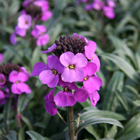Garden Alphabet: Joshua Tree (Yucca brevifolia)
There is a distinct alien look to Joshua Trees as you drive across the California High Desert. Their gnarled, out-stretched arms almost look like they are stumbling across the desert, headed to some secret location to plan their next move. I took this photo while we visiting the Antelope Valley Desert Museum. The trees just happened to be in bloom and the flowers look just as alien as the rest of the tree. Joshua Trees only grow in very specific area of the desert and are under pressure from surrounding development for both residential and industrial reasons.
Joshua Tree (Yucca brevifolia)
Yucca brevifolia is a plant species belonging to the genus Yucca. It is tree-like in habit, which is reflected in its common names: Joshua tree, yucca palm, tree yucca, and palm tree yucca.[2][3][4]
This monocotyledonous tree is native to southwestern North America in the states of California, Arizona, Utah and Nevada, where it is confined mostly to the Mojave Desert between 400 and 1,800 meters (1,300 and 5,900 ft) elevation. It thrives in the open grasslands of Queen Valley and Lost Horse Valley in Joshua Tree National Park. A dense Joshua tree forest also exists in Mojave National Preserve, in the area of Cima Dome.
In addition to the nominate subspecies Yucca brevifolia subsp. brevifolia, two other subspecies have been described:[5] Yucca brevifolia subsp. jaegeriana (the Jaeger Joshua tree or Jaeger’s Joshua tree or pygmae yucca) and Yucca brevifolia subsp. herbertii (Webber’s yucca or Herbert Joshua tree), though both are sometimes treated as varieties[6][7][8] or forms.[9]
The name Joshua tree was given by a group of Mormon settlers who crossed the Mojave Desert in the mid-19th century. The tree’s unique shape reminded them of a Biblical story in which Joshuareaches his hands up to the sky in prayer.[10][11][12] Ranchers and miners who were contemporary with the Mormon immigrants also took advantage of the Joshua tree, using the trunks and branches as fencing and for fuel for ore-processing steam engines. It is also called izote de desierto.[13] It was first formally described in the botanical literature as Yucca brevifolia by George Engelmann in 1871 as part of the Geological Exploration of the Fortieth Parallel.[14] — Wikipedia
More information on Joshua Tree (Yucca brevifolia):
- Acanthus
- Amaryllis
- Apricot (Prunus armeniaca)
- Azalea
- Banana
- Bonsai
- Bougainvillea
- Brugmansia
- California Poppy (Eschscholzia californica)
- Calla Lily (Zantedeschia aethiopica)
- Castor Bean (Ricinus)
- Caltapa
- Chives (Allium schoenoprasum)
- Clematis
- Camellia
- Currant (Ribes)
- Dahlia
- Datura
- Japanese Cherry (Prunus serrulata)
- Daffodil (Narcissus)
- Dietes (Fortnight Lily)
- Dudleya
- Echinacea
- Ecualyptus
- Freesia
- Fungi
- Grape (Vitis vinifera)
- Hibiscus (Malvaceae)
- Iris
- Kniphofia “Red Hot Poker”
- Lantana
- Kousa Dogwood (Cornus kousa)
- Magnolia x soulangeana (Saucer Magnolia/Tulip Tree)
- Marigold (Calendula officinalis)
- Matilija Poppy (Romneya)
- Morning Glory (Convolvulaceae)
- Nandina
- Orange
- Orchid from the Southern California Spring Garden Show 2013
- Oriental Poppy (Papaver orientale)
- Polygonatum (Solomon’s Seal)
- Paperwhites
- Primula (Primrose)
- Queen Anne’s Lace (Daucus carota)
- Rudbeckia
- Salvia
- Squirrel
- Succulents
- Sweet Potato (Ipomoea batatas)
- Tomato
- Water Lily (Nymphaeaceae)







